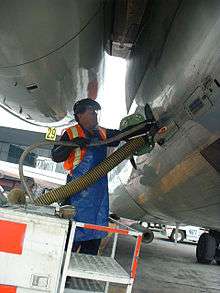Aircraft ground handling

In aviation, aircraft ground handling defines the servicing of an aircraft while it is on the ground and (usually) parked at a terminal gate of an airport.
Overview


Many airlines subcontract ground handling to airports, handling agents or even to another airline. According to the International Air Transport Association (IATA), conservative estimates indicate airlines outsource more than 50 per cent of the ground handling that takes place at the world's airports.[1] Ground handling addresses the many service requirements of an airliner between the time it arrives at a terminal gate and the time it departs on its next flight. Speed, efficiency, and accuracy are important in ground handling services in order to minimize the turnaround time (the time during which the aircraft must remain parked at the gate).[2] Faster turnarounds for lower ground times are correlated to better profits.[3]
Airlines with less-frequent service or fewer resources at a particular location sometimes subcontract ground handling or on-call aircraft maintenance to another airline, as it is a short-term cheaper alternative to setting up its own ground handling or maintenance capabilities.
Airlines may participate in an industry-standard Mutual Assistance Ground Service Agreement (MAGSA). The MAGSA is published by the Air Transport Association (the current version is from 1981) and is used by airlines to assess prices for maintenance and support to aircraft at so-called MAGSA Rates, which are updated annually based on changes in the U.S. Producer Price Index. Airlines may choose to contract for ground handling services under the terms of a Standard Ground Handling Agreement (SGHA) published in the International Air Transport Association (IATA) Airport Handling Manual.[4] Airlines may also contract for ground handling services under non-standard terms.
Most ground services are not directly related to the actual flying of the aircraft, and instead involve other tasks. The major categories of ground handling services are described below.
Cabin service
The primary aim of this service offering is to ensure passenger comfort. While cabin cleaning comprises the bulk of the effort, it also includes tasks such as replenishing onboard consumables (soap, tissues, toilet paper, reading materials) and washable items like pillows and blankets.
Catering
Catering includes the unloading of unused food and drink from the aircraft, and the loading of fresh food and drink for passengers and crew. Airline meals are typically delivered in Airline service trolleys. Empty or trash-filled trolley from the previous flight are replaced with fresh ones. Meals are prepared mostly on the ground in order to minimize the amount of preparation (apart from chilling or reheating) required in the air.
While some airlines provide their own catering, others have either owned catering companies in the past and divested themselves of the companies, or have outsourced their catering to third-party companies. Airline catering sources include the following companies:
- Airline Services & Logistics PLC(EPZE)
- American Airlines
- Atlas Catering (Royal Air Maroc's catering service)
- Cara Operations
- Cathay Pacific's Cathay Pacific Catering Services
- Chelsea Food Services
- Gate Gourmet
- KLM's KLM Catering Services
- LSG Sky Chefs
- Q Catering (Qantas)
- Servair
- Thai Airways's Thai Catering Services
- United Airlines
Ramp service
.jpg)
.jpg)


This includes services on the ramp or apron, such as:
- Guiding the aircraft into and out of the parking position (by way of aircraft marshalling),
- Towing with pushback tractors
- Lavatory drainage
- Water cartage (typically non-potable for lavatory sink use)
- Air conditioning (more common for smaller aircraft)
- Airstart units (for starting engines)
- Luggage handling, usually by means of beltloaders and baggage carts
- Gate checked luggage, often handled on the tarmac as passengers disembark
- Air cargo handling, usually by means of cargo dollies and cargo loaders
- Catering trucks
- Refueling, which may be done with a refueling tanker truck or refueling pumper
- Ground power (so that engines need not be running to provide aircraft power on the ground)
- Passenger stairs (used instead of an aerobridge or airstairs, some budget airlines use both to improve turnaround speed)
- Wheelchair lifts, if required
- Hydraulic mules (units that provide hydraulic power to an aircraft externally)
- Deicing
Passenger service

This includes services inside the airport terminal such as:
- Providing check-in counter services for the passengers departing on the customer airlines.
- Providing gate arrival and departure services. The agents are required to meet a flight on arrival as well as provide departure services including boarding passengers and closing the flight.
- Staffing the transfer counters, customer service counters and airline lounges.
Field operation service
This service dispatches the aircraft, maintains communication with the rest of the airline operation at the airport and with Air Traffic Control.
List of notable handling agents
Asia
Bangladesh
Hong Kong
 Cathay Pacific
Cathay Pacific Hong Kong Airport Services (parent company: Cathay Pacific)
Hong Kong Airport Services (parent company: Cathay Pacific) Hong Kong Aviation Ground Services (parent company: Hong Kong Airlines)
Hong Kong Aviation Ground Services (parent company: Hong Kong Airlines) Jardine Aviation Services (parent company: Jardine Matheson)
Jardine Aviation Services (parent company: Jardine Matheson) SATS HK
SATS HK United Airlines
United Airlines
Japan
-
 All Nippon Airways
All Nippon Airways -
 JAL Ground Service
JAL Ground Service -
 Japan Airport Ground Handling
Japan Airport Ground Handling -
 Japan Airport Service Co., Ltd.
Japan Airport Service Co., Ltd. -
 International Air Cargo Terminal Co., Ltd.
International Air Cargo Terminal Co., Ltd.
Korea
Laos
Singapore
Sri Lanka
Taiwan
 China Airlines
China Airlines Taiwan Airport Service Co., Ltd.
Taiwan Airport Service Co., Ltd. Evergreen Airlines Service
Evergreen Airlines Service
Thailand
Vietnam Airport Ground Services Co., Ltd (VIAGS)
Europe
Belgium
Cyprus
Denmark
Greece
Italy
Latvia
Lithuania
Netherlands
Poland
-
 Baltic Ground Services
Baltic Ground Services -
 LS Airport Services
LS Airport Services -
 Welcome Airport Services
Welcome Airport Services
Sweden
-
 SAS Ground Handling
SAS Ground Handling -
 AVIATOR Ground Handling
AVIATOR Ground Handling
Switzerland
Turkey
United Kingdom
Middle East
-
 ASE – Egypt Member ASE Group
ASE – Egypt Member ASE Group -
 ASE – UAE Member Of ASE Group
ASE – UAE Member Of ASE Group -
 ASE – Morocco Member Of ASE Group
ASE – Morocco Member Of ASE Group -
 New Star Aviation Services
New Star Aviation Services -
 dnata (Also active in other countries)
dnata (Also active in other countries) -
 Egypt Air Ground Services
Egypt Air Ground Services -
 HAVAS Ground Handling Co.
HAVAS Ground Handling Co.  Oman Air
Oman Air Shaheen Airport Services
Shaheen Airport Services Royal Airport Services
Royal Airport Services BAS (Bahrain Airport Services)
BAS (Bahrain Airport Services)
North and Central America
Canada
-
 Handlex (now fully merged on Swissport)
Handlex (now fully merged on Swissport) -
 Swissport
Swissport -
 Airport Terminal Services (ATS)
Airport Terminal Services (ATS) -
 Menzies Aviation
Menzies Aviation
Cuba
Mexico
-
 Kion de Mexico
Kion de Mexico -
 Aeromexico Servicios
Aeromexico Servicios
United States
-
 Airport Terminal Services (ATS)
Airport Terminal Services (ATS) -
 DAL Global Services
DAL Global Services -
 Envoy Air
Envoy Air -
 Mickey Heart
Mickey Heart  Universal Aviation
Universal Aviation Simplicity
Simplicity Piedmont Airlines
Piedmont Airlines SkyWest Airlines
SkyWest Airlines G2 Secure Staff
G2 Secure Staff
References
- ↑ International Air Transport Association, Ground Handling, International Air Transport Association, archived from the original on 5 October 2013
- ↑ Gomez, F; Scholz, D (2009), Improvements to ground handling operations and their benefits to direct operating costs (PDF), Hamburg University of Applied Sciences, archived from the original (PDF) on 28 October 2013
- ↑ "The correlation between airline ground time and profits". AirInsight. May 8, 2017.
- ↑ International Air Transport Association, Airport Handling Manual (AHM), International Air Transport Association, archived from the original on 18 October 2013
External links and further reading
- International Air Transport Association, IATA Ground Handling Council, International Air Transport Association
- Ground Handling International
- ISO 9001:2008—Quality management systems